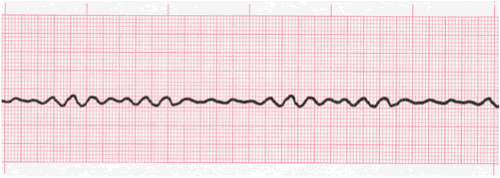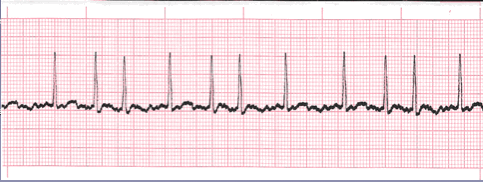2021 Arrhythmia Interpretation Competency

This quiz fulfills your 2021 Rhythm interpretation competency. You must obtain 80% or higher to pass.
Make sure to print out your certificate completion with your Full Name before logging out of the quiz.
Good luck
- 1.
What intervention is priority for a patient in this rhythm?
- A.
Defibrillation
- B.
Cardioversion
- C.
Check the patient, Check for a pulse
- D.
No intervention needed
Correct Answer
C. Check the patient, Check for a pulseExplanation
The priority intervention for a patient in this rhythm is to check the patient and check for a pulse. This is because before proceeding with any further interventions such as defibrillation or cardioversion, it is crucial to assess the patient's condition and determine if they have a pulse or not. This initial assessment will help guide the appropriate course of action and ensure the patient receives the necessary treatment.Rate this question:
-
- 2.
What is this rhythm?
- A.
Ventricular Tachycardia
- B.
Ventricular Fibrillation
- C.
Idioventricular
- D.
Complete heart block
- E.
Asystole
Correct Answer
B. Ventricular FibrillationExplanation
Ventricular fibrillation is a chaotic and irregular rhythm of the heart where the ventricles quiver instead of contracting effectively. This results in a lack of blood flow to the body and is a life-threatening condition that can lead to cardiac arrest. It is characterized by a rapid and disorganized pattern on an electrocardiogram (ECG). Immediate medical intervention, such as defibrillation, is required to restore a normal heart rhythm and prevent further complications.Rate this question:
-
- 3.
Case Scenario: patient JB is determined to be in this rhythm without a pulse and he is not breathing. What is the priority intervention?
- A.
Start compressions
- B.
Leave the patient and call the doctor
- C.
Defibrillation
- D.
Respiratory management.
Correct Answer
A. Start compressionsExplanation
The priority intervention in this case is to start compressions. This is because the patient is determined to be in a rhythm without a pulse and is not breathing. Starting compressions immediately can help to circulate oxygenated blood to vital organs and increase the chances of survival. It is important to initiate compressions as soon as possible in order to maintain blood flow and provide the best chance for a positive outcome.Rate this question:
-
- 4.
What is this rhythm?
- A.
Third Degree Heart Block
- B.
Sinus Bradycardia
- C.
PVCs
- D.
Junctional Rhythm
Correct Answer
A. Third Degree Heart BlockExplanation
Third Degree Heart Block is a condition where there is a complete blockage of electrical signals between the atria and ventricles of the heart. This results in the atria and ventricles beating independently of each other, causing a slow and irregular heart rhythm. This rhythm is characterized by a regular P wave and QRS complex, but with no relationship between them. The atria and ventricles are completely dissociated, leading to a slow heart rate and potential symptoms such as dizziness, fainting, and fatigue. Treatment for Third Degree Heart Block usually involves the placement of a pacemaker to regulate the heart rhythm.Rate this question:
-
- 5.
What is this rhythm?
- A.
Ventricular Tachycardia
- B.
Sinus Tachycardia
- C.
Supraventricular Tachycardia
- D.
Accelerated Idioventricular Rhythm
Correct Answer
C. Supraventricular TachycardiaExplanation
Supraventricular tachycardia (SVT) is the correct answer because it is a rhythm that originates above the ventricles in the atria or AV node. This rhythm is characterized by a fast heart rate, usually between 150 and 250 beats per minute. It can cause symptoms such as palpitations, dizziness, and shortness of breath. SVT can be caused by various factors, including stress, caffeine, and certain medications. Treatment options for SVT may include medications, vagal maneuvers, or in some cases, catheter ablation.Rate this question:
-
- 6.
What is this rhythm?
- A.
Normal Sinus Rhythm
- B.
Sinus Arrhythmia
- C.
Normal Sinus Rhythm with 2 unifocal PVCs
- D.
Sinus Tachycardia with 2 mutifocal PACs
Correct Answer
C. Normal Sinus Rhythm with 2 unifocal PVCsExplanation
The given rhythm is identified as "Normal Sinus Rhythm with 2 unifocal PVCs." This means that the electrical activity of the heart is normal, with a regular sinus rhythm, but there are also two premature ventricular contractions (PVCs) occurring. PVCs are extra heartbeats that originate from the ventricles instead of the sinus node. In this case, the PVCs are unifocal, meaning they have the same shape and originate from the same location in the ventricles.Rate this question:
-
- 7.
The patient is determined to be in the below rhythm without a pulse. What is this rhythm?
- A.
Atrial Tachycardia
- B.
Sinus Tachycardia
- C.
Supraventricular Tachycardia
- D.
Pulseless Ventricular Tachycardia
Correct Answer
D. Pulseless Ventricular TachycardiaExplanation
Pulseless Ventricular Tachycardia is the correct answer because it is a life-threatening rhythm characterized by a rapid heart rate originating from the ventricles, but without a pulse. In this rhythm, the ventricles are beating too fast and ineffectively, leading to a lack of blood flow to the body. Prompt intervention, such as CPR and defibrillation, is necessary to restore a normal heart rhythm and circulation.Rate this question:
-
- 8.
Case scenario: The below patient was determined to be unresponsive, not breathing and without a pulse. What is this rhythm?
- A.
Pulseless Electrical Activity (PEA)
- B.
Asystole
- C.
Sinus Bradycardia with a pulse
- D.
Junctional rhythm with a pulse
Correct Answer
A. Pulseless Electrical Activity (PEA)Explanation
In this case scenario, the patient is described as being unresponsive, not breathing, and without a pulse. Pulseless Electrical Activity (PEA) is a rhythm where there is electrical activity in the heart, but it does not result in a palpable pulse. This means that even though there is some electrical activity, the heart is not effectively pumping blood to the rest of the body. Asystole, on the other hand, is a flatline rhythm with no electrical activity in the heart. Sinus Bradycardia with a pulse and Junctional rhythm with a pulse both indicate that there is a pulse present, which contradicts the given scenario. Therefore, the correct answer is Pulseless Electrical Activity (PEA).Rate this question:
-
- 9.
What is this rhythm?
- A.
Sinus Tachycardia
- B.
Atrial Fibrillation
- C.
Ventricular Fibrillation
- D.
Atrial Flutter 4:1
Correct Answer
B. Atrial FibrillationExplanation
Atrial fibrillation is the correct answer because it is a type of abnormal heart rhythm characterized by irregular and rapid electrical signals in the atria, the upper chambers of the heart. This results in a rapid and irregular heartbeat. Sinus tachycardia refers to a fast but regular heart rhythm originating from the sinus node, while ventricular fibrillation is a life-threatening arrhythmia that occurs in the ventricles, the lower chambers of the heart. Atrial flutter 4:1 refers to a specific type of atrial flutter where there are four atrial electrical signals for every one ventricular contraction.Rate this question:
-
- 10.
What is this rhythm?
- A.
Ventricular Rhythm
- B.
AV (Atrial & Ventricular) Paced Rhythm
- C.
Ventricular Paced Rhythm
- D.
Atrial Paced Rhythm
Correct Answer
B. AV (Atrial & Ventricular) Paced RhythmExplanation
The correct answer is AV (Atrial & Ventricular) Paced Rhythm. This rhythm is characterized by the presence of both atrial and ventricular pacing spikes on the ECG. It indicates that both the atria and ventricles are being paced by an external pacemaker, usually due to a malfunctioning or blocked conduction system. This rhythm can be identified by the absence of normal P waves and the presence of pacing spikes before each QRS complex.Rate this question:
-
- 11.
What is this rhythm?
- A.
Normal Sinus Rhythm
- B.
Sinus Arrhythmia
- C.
Sinus Tachycardia
- D.
Atrial fibrillation
Correct Answer
A. Normal Sinus RhythmExplanation
Normal Sinus Rhythm refers to the normal electrical activity of the heart, where the heart rate is between 60-100 beats per minute and the rhythm is regular. This rhythm is characterized by a consistent P wave preceding each QRS complex and a normal PR interval. It indicates that the electrical signals in the heart are originating from the sinus node, which is the natural pacemaker of the heart.Rate this question:
-
- 12.
What is this rhythm?
- A.
Ventricular Fibrillation
- B.
Asystole
- C.
Supraventricular Tachycardia
- D.
Torsades de Pointes (TdP)
Correct Answer
D. Torsades de Pointes (TdP)Explanation
Torsades de Pointes (TdP) is a type of abnormal heart rhythm characterized by rapid, irregular, and twisting patterns on an electrocardiogram (ECG). It is typically caused by an imbalance in the electrical activity of the heart, specifically in the ventricles. TdP can lead to a dangerous condition called ventricular fibrillation, which can be life-threatening if not treated promptly. Asystole refers to a complete absence of electrical activity in the heart, while supraventricular tachycardia is a rapid heart rate originating above the ventricles. Therefore, TdP is the most appropriate answer as it matches the description provided.Rate this question:
-
- 13.
Case Scenario: Patient JB is in the below rhythm. The patient is determined not to be breathing and he is without a pulse. You call for help and start compressions. What type of emergency is this?
- A.
Rapid Response Team (RRT)
- B.
Code Blue in the Hospital/911 if you are outside the hospital
- C.
Not an emergency, you can handle this alone
- D.
Stroke Alert
Correct Answer
B. Code Blue in the Hospital/911 if you are outside the hospitalExplanation
This scenario describes a patient who is not breathing and without a pulse, indicating a cardiac arrest. In this situation, immediate medical intervention is required to resuscitate the patient. The correct answer, "Code Blue in the Hospital/911 if you are outside the hospital," refers to the emergency response protocol for a cardiac arrest. A "Code Blue" is called in a hospital setting to alert the medical team to respond to a cardiac arrest, while calling 911 is necessary if the incident occurs outside the hospital.Rate this question:
-
Quiz Review Timeline +
Our quizzes are rigorously reviewed, monitored and continuously updated by our expert board to maintain accuracy, relevance, and timeliness.
-
Current Version
-
Mar 22, 2023Quiz Edited by
ProProfs Editorial Team -
Jun 17, 2020Quiz Created by
Regina.Rich
 Back to top
Back to top















